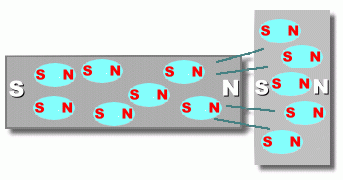|
You probably know how magnets work ... a north pole on one magnet will attract the south pole on another, and they will stick together. Alternately, two north poles will repel each other. The question here is: "Why does a magnet attract an ordinary piece of metal? What is the north pole of the magnet attracting, if the metal isn't magnetised itself, and has no 'poles'"? A good question. We'll have to look at a close-up of a magnet and a piece of metal to answer it. The reason a magnet will stick to a non-magnetised piece of metal is very similar to the reason why a balloon that you have charged with static electricity will stick to an uncharged wall.
What can make the molecules in a magnet line up this way? Well, magnetic force causes a 'pull' when unlike poles come near each other, and a 'push' when the same poles are near each other. By rubbing a magnet in one direction along a piece of metal, the magnet's strong force can cause many of the molecules in the metal to align their poles, turning the metal into an artificial magnet. A natural magnet is a piece of rock that was once deep under the ground, and molten. The earth has a magnetic field, but it is very weak. Ordinarily it is not strong enough to pull the molecules in a metal into the same direction. But when the rock is molten (liquid), the molecules can turn more easily. So molten rock will have its molecules lined up according to the direction of the earth's magnetic field. Once the rock solidifies, the poles are locked in place, and the rock is a permanent magnet. Only certain metals, like iron, can have molecules with poles that all point in the same direction. These metals are called ferromagnetic. You can make a magnet from iron, but lead won't work. So how does a magnet cause a non-magnetic piece of metal to stick to it? Well, the metal must be ferromagnetic to start with. Here's what happens:
|
 On the left is a piece of ordinary metal. Its molecules are charged, and polarized, which means each molecule has a positive and negative end, which for convenience we will call north and south.
On the left is a piece of ordinary metal. Its molecules are charged, and polarized, which means each molecule has a positive and negative end, which for convenience we will call north and south.  Here's a magnet. In this metal, many of the molecules are aligned the same way. They all seem to have their north poles pointing in one direction, and their south poles in another. The electromagnetic fields of force all point the same way ... this makes one end of the metal 'north', and the other 'south'. The more molecules that point the same way, the stronger the electromagnetic force that will occur in the metal as a whole. All the forces point in the same direction.
Here's a magnet. In this metal, many of the molecules are aligned the same way. They all seem to have their north poles pointing in one direction, and their south poles in another. The electromagnetic fields of force all point the same way ... this makes one end of the metal 'north', and the other 'south'. The more molecules that point the same way, the stronger the electromagnetic force that will occur in the metal as a whole. All the forces point in the same direction. When you bring the north end of a magnet near to the unpolarized piece of metal, the electromagnetic force from the magnet makes all the molecules of the metal turn so that the south poles are facing the magnet (because they are attracted to its north pole).
When you bring the north end of a magnet near to the unpolarized piece of metal, the electromagnetic force from the magnet makes all the molecules of the metal turn so that the south poles are facing the magnet (because they are attracted to its north pole).